

Prior Episodes | 7956 (21 BBY) | Next Episodes
Continuity & Analysis
Star Wars: The Clone Wars - Trespass (2009) [S1E15]
Arrogance diminishes wisdom.
"Republic outpost, overrun! The Jedi have lost all contact with the clone security force stationed
on the bleak, snow-covered planet of Orto Plutonia. Obi-Wan Kenobi and Anakin Skywalker,
accompanied by dignitaries from the nearby moon of Pantora are sent to investigate the
disappearance of the clone troopers on the desolate and forbidding landscape..."
Star Wars: The Clone Wars - Blue Shadow Virus (2009) [S1E17]
Fear is a disease; hope is its only cure.
"Battle droids on Naboo! As the Separatist rebellion rages through the galaxy, even peaceful
planets are threatened. Following the discovery of Separatist droids wandering the grassy
wasteland, Naboo is once again on high alert. Fearing their home is facing another invasion,
Senator Amidala and Representative Binks race to Naboo to assess the situation. Meanwhile,
near the Gungan swamplands, an even graver threat is about to be discovered..."
Star Wars: The Clone Wars - Mystery of a Thousand Moons (2009) [S1E18]
A single chance is a galaxy of hope.
"Hard-pressed Jedi and their valiant clone troopers have thwarted an insidious Separatist
plot to plant bombs loaded with the deadly Blue Shadow Virus in key Republic
systems. Obi-Wan Kenobi and Anakin Skywalker have captured the vile scientist
behind the nefarious scheme: Doctor Nuvo Vindi. Now the Jedi plan to transport
Vindi to the Republic capital for trial..."


CONTINUITY
'Trespass' is a standalone episode which is connected to the other two episodes by chronological order, and loosely by theme, as these
three episodes involve native populations of worlds caught up in the war. 'Blue Shadow Virus' and 'Mystery of a Thousand Moons' form
a single storyline. The chronological order of episodes is as given by Lucasfilm, and follows their release order, omitting S1E16 which
occurs earlier in the chronology. The planets Orto Plutonia and Iego are seen for the first time. Three worlds are seen in these episodes:

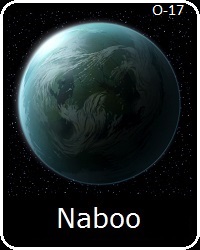
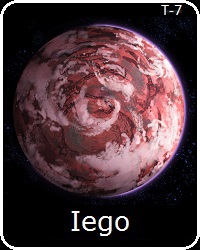
- Orto Plutonia is a wet and frozen planet located in the Sujimis Sector, in the Trailing Sectors of the Outer Rim. It is orbited by at least one moon, which
is usually said to be the inhabited moon of Pantora. It was considered by the Pantorans, and as a result also the Republic, to be an uninhabited desert
until they discovered it to be the homeworld of the apparently unknown Talz during the Clone Wars. The Talz are a furry, four-eyed humanoid species.
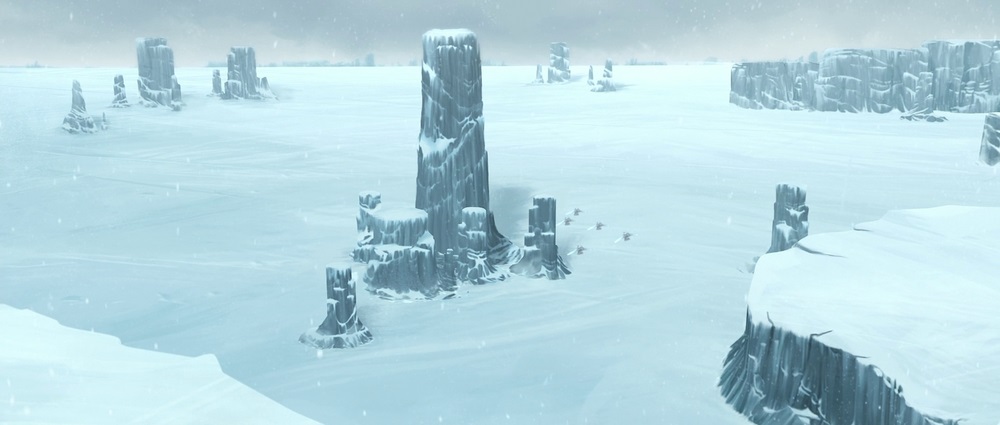
- As a supposedly uninhabited world, Orto Plutonia fell under the jurisdiction of Pantora, the main inhabited world in the star system. Nevertheless,
Anakin's statement that he though it was "uninhabited and therefore it's not aligned", shows that the Republic has different legal classifications for
different types of worlds. It may be the Republic considers uninhabited worlds within its 'territory' to be not part of the Republic, or that these
worlds are under the domain of the Republic but not under the authority of any galactic interest or regional authority. Senator Chuchi says that
"if there are lifeforms here, then the Senate must decide jurisdiction", which shows that the presence of inhabitants changes a world's status and
therefore classification. Chairman Cho mentions the Convention of Civilized Systems, a Republic treaty which defines the norms and mores for
interstellar affairs. Cho's statements indicate that 'primitive' non-spacefaring races are not covered under the law by these rules, suggesting
there is more leeway to violate their rights and sovereignty.
Main Article: The Galactic Republic and the Neutral Systems

The narrator at the beginning of the episode calls Pantora "near-by", which suggests it is probably in the same star
system. A 2015 book determined that Pantora is a moon of Orto Plutonia itself, which has become the standard concept.
Given this retcon, it seems very unlikely the Talz would be unknown. Cho's statement that it is "impossible, our explorers
have much time here over the long history of Pantora", is an understatement. After thousands of years of orbiting and
using the planet, it seems unlikely they wouldn't have ever run afoul of these very territorial people. Considering they
aren't anywhere near advanced enough to master space travel, and very isolationist, it seems a strange retcon to make
this species, seen out and about the galaxy two decades later in Episode IV, have been unknown, unadvanced, and
live on a planet with no spacefaring infrastructure. Even after contact it would still be rare to see one off of their planet.
Chuchi does say they will recognize their sovereignty, so perhaps further contact was made by the Republic after this
episode, but it doesn't really address why the Talz were chosen to fill this role in this story. This also makes it next to
impossible to reasonably explain the Talz Jedi Knight, Foul Moudama, seen in Clone Wars Chapter 24 and Chapter 25,
set only two years later. The Jedi don't train adults, and no Jedi becomes a Knight in two years. This could be reconciled
by giving him some insanely unlikely and convoluted backstory, something that wouldn't have been necessary if the Talz
hadn't been needlessly given such a specifically limited history. This is a lack of attention to detail in continuity.
- The federal nature of the Republic is clear from the instance of the Chairman that internal affairs of Pantora don't fall under the jurisdiction of
the Senate or the Jedi. The sovereignty of Republic worlds and their domains is respected within the framework of interstellar law. It is
revealed that the speaker of the Pantoran assembly has power to overrule Chairman, and designates power to negotiate to Senator Chuchi,
so is the moon is some type of democracy, and two highest ranking members of the government, their leader and their representative in
the Galactic Senate, are subject to oversight by their legislature. This does not prove that Republic members must be democratic in some
fashion, but is further evidence to support that notion.
Main Article: The Galactic Republic and the Neutral Systems
- Queen Neeyutnee has been elected leader of Naboo, replacing Queen Jamillia, sometime between this episode and Episode II. Based on
the reigns of the previous Queens, one term is two years, and Neeyutnee was elected at the end of 7955 (22 BBY). She will be Queen until
near the end of 7957 (20 BBY), when she will be succeeded by Queen Apailana, seen in Episode III

Why is the aerosolized virus gas blue? As a weapon it would be best if it were invisible, and it doesn't make much
sense that it isn't. Tiny airborne particles which contain a virus are invisible, and whatever gas medium that carries
it should not be dense and exotic enough to have a distinctly blue color in an atmosphere. If dense gas of exotic
molecules is required to aerosolize this virus, it is likely the gas itself would harm or kill its intended carriers,
greatly reducing its effectiveness. The creators of this episode likely decided it was more exciting if the gas could
be seen and avoided like an obstacle by the characters, and made it blue because it is the Blue Shadow Virus.
- Virus weapons are of great use to the Separatists, in that they target only living beings and leave droids unharmed, similar to their defoliator
weapon. These are also weapons useful to the Sith, as both kill indiscriminately, will lead to widespread devastation and death, and use
terror to inspire fear. The difference here is that unlike the defoliator, a galaxy wide plague would harm Separatist worlds, even if
the plague were only released on loyal Republic worlds at first. While this does not matter to the Sith, it would matter to the Separatist
loyalists the Alliance relies on, and cannot be openly used as a weapon. As such, the project is kept secret.
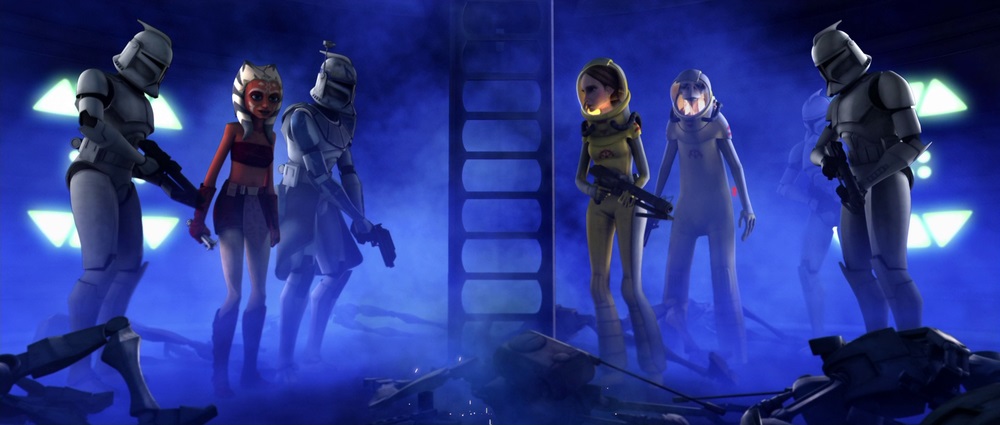
- Obi Wan suggests to an exasperated Anakin that he is just better at hiding his worry. The discipline and patience needed to keep one's feelings
from disrupting one's composure is precisely what Jedi teachings, practices, and doctrines are supposed to impart to a Jedi. Anakin is
capable of this, but his inability to conquer his fear of loss, caused by his attachment and sentimentality, leaves him vulnerable to this in
situations involving those he cares deeply about.
- Republic clone 'ordinance troopers' are seen, in this case brought in to handle the explosive bombs meant to disseminate the virus.
- Droideka 'destroyer' droid shields can be breached by solid objects which are moving slow enough, as has been seen before. This is now shown
to include the hilt of a lightsaber, which can be inserted through the shield, then activated to damage or destroy the battle droid while its
shield is still active. This indicates something of the limitations of their power source and shield emitters in terms of energy output.
Main Article: Shields, Deflectors, and Ray Shields
- Iego is a terrestrial planet located in the Ash Worlds Sector, in the Slice region of the Outer Rim. It is a relatively minor planet, despite its notoriety
for its unusually large number of moons. Although much of the planet is a desert, it is home to a unique ecosystem. Iego is a world colonized
by various peoples from different Republic worlds, due to its habitability and unique beauty. It's location in the Slice makes it a remote outpost
of Core civilization near Hutt space. One of the many moons of Iego is Millius Prime, which is the homeworld of the Diathim.

- Anakin asks R2 to amplify the signal coming to Iego from Naboo, either because of the distance, the strength of the transmitter in the lab on
Naboo, or because the lab is located underground, or some combination of these factors.
Main Article: Hyperspace Communications
- The Separatist energy field uses dish emitters like other laser energy weapons, including the lasers on Separatist spider droid walkers,
LAAT gunships used by the Republic, and decades later, the Death Star battlestations. This larger dish laser system is meant to
show the development of larger scale laser weapons.

- The Diathim come from Millius Prime, one of the moons of Iego. They are referred to colloquially as the angels, as Anakin did in Episode I.
In keeping with a classic SW theme, there are many features of the galaxy, including names of characters and groups, which are meant
to suggest the possibility that our ancient concepts or myths on Earth could be based on stories that originate from Humans that don't
come from this planet, or even this galaxy. There is no direct implication that this is the case, but as this all occurred a long time ago, it is
meant to be considered. Another major theme of SW is the cyclical nature of history and events, so another implication could be that
many things repeat themselves throughout the universe, including races like Humans, words for concepts, sociopolitical events, and
archetypal models. Beautiful and peaceful beings with a glow and wings called angels could represent either concept, or both.
ANALYSIS
Chairman Cho is an arrogant person who believes himself superior, and is very self-centered and selfish. He typifies the kind of honest,
power-hungry imperialists which exist in any society, and can gain power even in a peaceful democracy. His primary concern at the outpost is
with weapons and shields, as in his mind, strength and power triumph. He is similarly concerned with maintaining rhetorical dominance over
all present, even respected Jedi, and the Senator from his own planet. Having asserted his claim over Orto Plutonia, he states regarding the Talz
that "whoever they are, they belong to us", which might be true in a jurisdictional sense, but shows a blatant disregard for the rights of others.
He calls them savages for being violent, then wants to be violent to assert his claim over their planet. He suggests it would be strategically wise
to betray them, saying "you can't lie to an animal", clearly unwilling to acknowledge the intelligence of people the Jedi had a conversation with.
He wanted a fight, started that fight, and after losing horribly, insists the fight be continued. His last words are "Peace? Never! I died for our
people". While certainly an obvious and a bit ridiculous caricature of an ultra-nationalist, Cho is nonetheless an important representation of
the kind of people on both sides of the war who would make willing and enthusiastic members of the coming Empire.
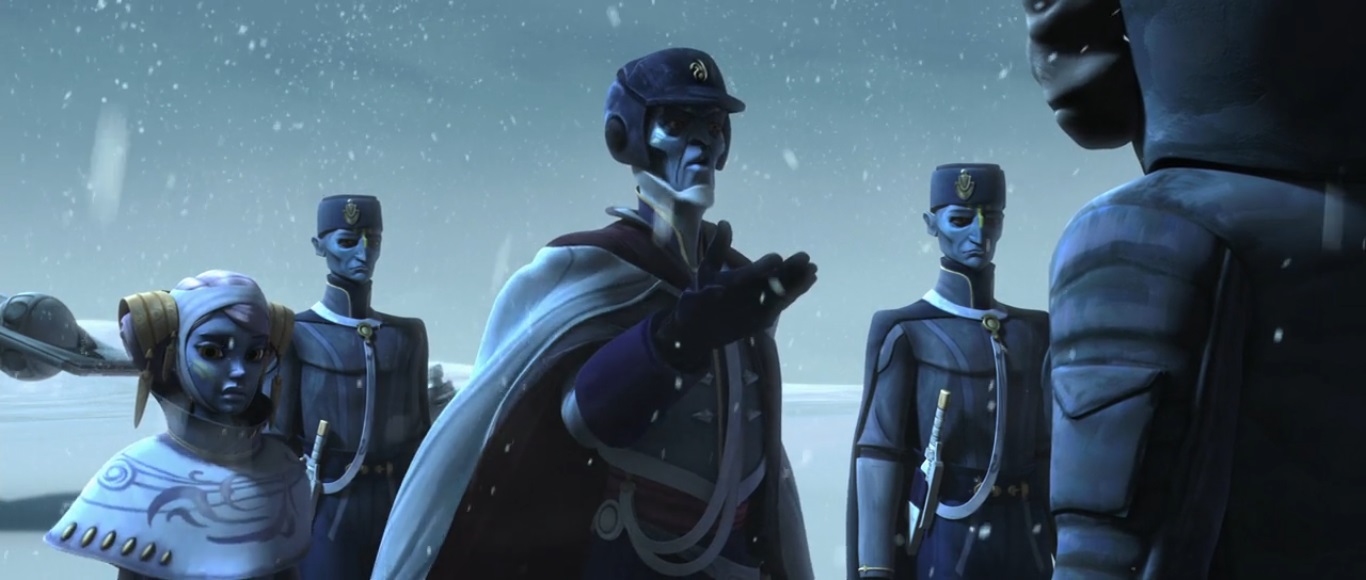
The Talz are upset about aliens acting superior and doing as they please on their planet. Like the Tuskens of Tatooine, and likely numerous other
examples across the galaxy, their right to their own world is ignored. The inevitable response to encroachment it elicits from them leads others
to brand them as dangerous savages, incapable of being reasoned with. The Talz seem generally respectful, and would likely have been willing
to allow a respectful Republic outpost on the planet, had they been asked for permission. Since the Pantorans were unaware of them, this was
obviously not done. The Jedi are determined to act as honorable intermediaries and create peace with respect. The supposedly 'civilized' and
more powerful side is unwilling to be reasonable or respectful. The Jedi insist the Pantorans make peace, as they are the ones in conflict with
the Talz. The Jedi always try to maintain impartiality, and not to advocate for their allies. Obi-Wan tells Senator Chuchi to keep the peace, so that
by following this example, one day all war will end. This hopeful position of the Jedi ignores the problem of warmongers, opportunists, and
imperialists, who exist in societies no matter what the political and social climate. Certainly, their influence and authority can be limited by
democratic processes and cultures emphasizing social values, but that still requires the constant vigilance of the righteous.
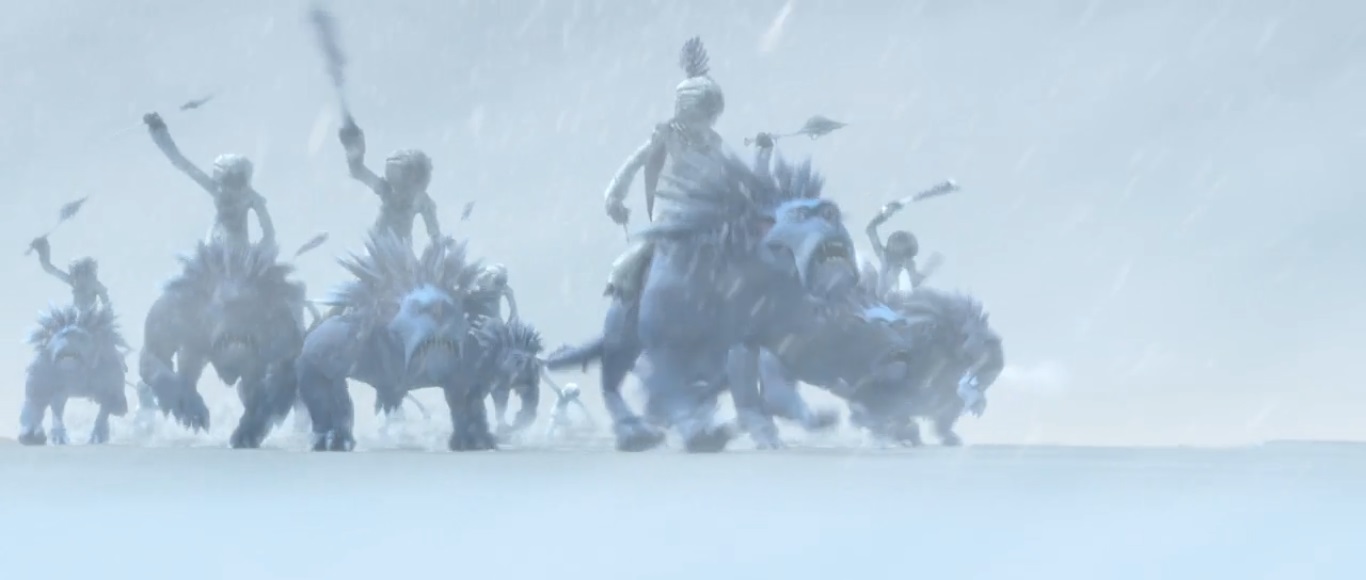
The Separatists continue to target Naboo for destabilization or destruction. In this instance, it is an ideal location for their secret virus
experiments, since there are Republic citizens to experiment on, and if they lose virus containment, a Separatist world or facility will not
become infected. Releasing the completed virus on Naboo will be a means to take revenge on the planet for its refusal to voin the Separatists,
and its loyalty to the Republic. Padme mentions that relations with the Gungans are "a bit strained", suggesting that despite the progress
in understanding and cooperation they have made, the long history of discord is not easy to overcome. The Separatists will continue to
attempt to divide the two races to undermine the unity of the planet, which has in the past saved the planet from outside influence.
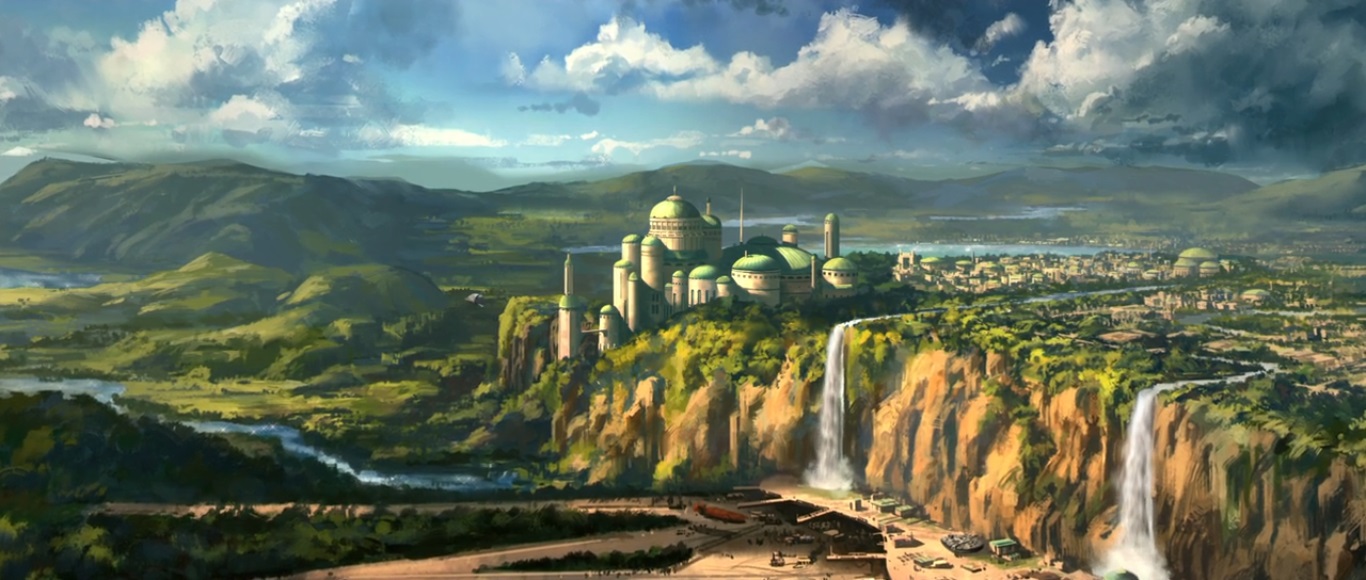
The Separatists invaded Iego near the beginning of the war, largely to consolidate territory, due to its proximity to the Separatist capital and
other major worlds. As the planet had little other strategic value, the Separatists chose to install a laser energy field to prevent the inhabitants
from leaving, freeing them from the need to leave forces on the planet to police the population and to serve as a defensive garrison.
The Jedi challenge the local myth about the ghost of Drall, which destroys all who try to leave Iego, which is in reality the energy weapon
left by the Separatists. The citizens of Iego are trapped by their own fear, as well as the device. The Jedi dispel their fear and remove their
metaphorical and literal cages, freeing them from the boundaries imposed upon them by others, as well as those they imposed on themselves.
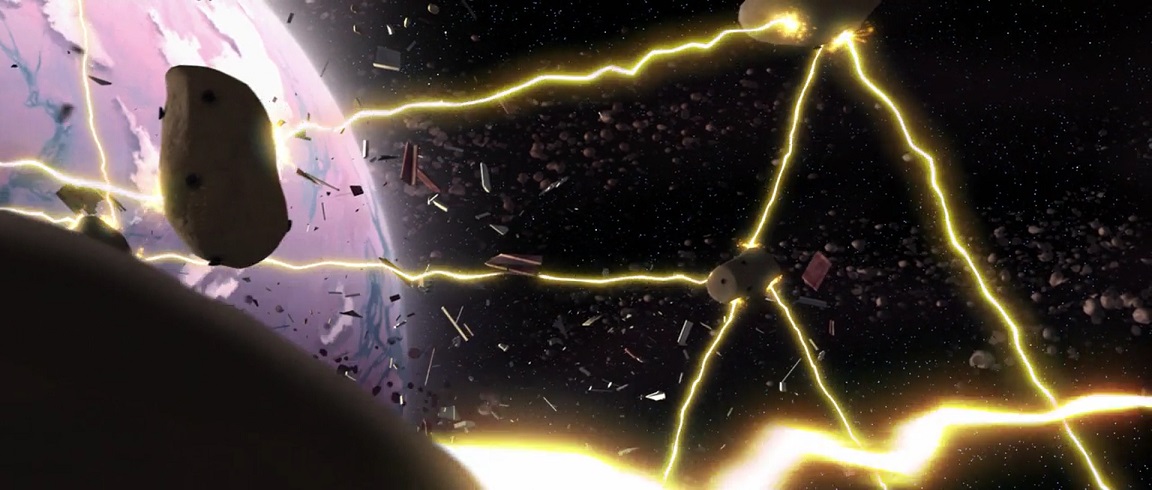
FURTHER ANALYSIS
Report Pending